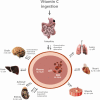Regulation of vitamin C homeostasis during deficiency
- PMID: 23892714
- PMCID: PMC3775232
- DOI: 10.3390/nu5082860
Regulation of vitamin C homeostasis during deficiency
Abstract
Large cross-sectional population studies confirm that vitamin C deficiency is common in humans, affecting 5%-10% of adults in the industrialized world. Moreover, significant associations between poor vitamin C status and increased morbidity and mortality have consistently been observed. However, the absorption, distribution and elimination kinetics of vitamin C in vivo are highly complex, due to dose-dependent non-linearity, and the specific regulatory mechanisms are not fully understood. Particularly, little is known about how adaptive mechanisms during states of deficiency affect the overall regulation of vitamin C transport in the body. This review discusses mechanisms of vitamin C transport and potential means of regulation with special emphasis on capacity and functional properties, such as differences in the K(m) of vitamin C transporters in different target tissues, in some instances demonstrating a tissue-specific distribution.
Figures


Similar articles
-
In vivo vitamin C deficiency in guinea pigs increases ascorbate transporters in liver but not kidney and brain.Nutr Res. 2014 Jul;34(7):639-45. doi: 10.1016/j.nutres.2014.07.004. Epub 2014 Jul 10. Nutr Res. 2014. PMID: 25150123
-
The Pharmacokinetics of Vitamin C.Nutrients. 2019 Oct 9;11(10):2412. doi: 10.3390/nu11102412. Nutrients. 2019. PMID: 31601028 Free PMC article. Review.
-
Classic human vitamin C depletion experiments: homeostasis and requirement for vitamin C.Nutrition. 1993 Jan-Feb;9(1):74, 85-6. Nutrition. 1993. PMID: 8467117 Review. No abstract available.
-
Vitamin C Deficiency in the Young Brain-Findings from Experimental Animal Models.Nutrients. 2021 May 15;13(5):1685. doi: 10.3390/nu13051685. Nutrients. 2021. PMID: 34063417 Free PMC article. Review.
-
Are lifestyle factors good predictors of retinol and vitamin C deficiency in apparently healthy adults?Eur J Clin Nutr. 2002 Feb;56(2):96-104. doi: 10.1038/sj.ejcn.1601291. Eur J Clin Nutr. 2002. PMID: 11857042
Cited by
-
High Vitamin C Status Is Associated with Elevated Mood in Male Tertiary Students.Antioxidants (Basel). 2018 Jul 16;7(7):91. doi: 10.3390/antiox7070091. Antioxidants (Basel). 2018. PMID: 30012945 Free PMC article.
-
Low Plasma Ascorbate Levels in Type 2 Diabetic Patients With Adequate Dietary Vitamin C.J Lab Physicians. 2021 Jun;13(2):139-143. doi: 10.1055/s-0041-1730751. Epub 2021 Jun 16. J Lab Physicians. 2021. PMID: 34483559 Free PMC article.
-
The Impact of Nutritional Components on Periodontal Health: A Literature Review.Nutrients. 2024 Nov 15;16(22):3901. doi: 10.3390/nu16223901. Nutrients. 2024. PMID: 39599688 Free PMC article. Review.
-
Micronutrients and the Periodontium: A Narrative Review.Cureus. 2025 Apr 4;17(4):e81694. doi: 10.7759/cureus.81694. eCollection 2025 Apr. Cureus. 2025. PMID: 40190829 Free PMC article. Review.
-
Higher doses of ascorbic acid may have the potential to promote nutrient delivery via intestinal paracellular absorption.World J Gastroenterol. 2021 Oct 28;27(40):6750-6756. doi: 10.3748/wjg.v27.i40.6750. World J Gastroenterol. 2021. PMID: 34790005 Free PMC article. Review.
References
-
- Agarwal M., Mehta P.K., Dwyer J.H., Dwyer K.M., Shircore A.M., Nordstrom C.K., Sun P., Paul-Labrador M., Yang Y., Merz C.N.B. Differing relations to early atherosclerosis between vitamin C from supplements vs. FOOD in the Los Angeles atherosclerosis study: A prospective cohort study. Open Cardiovasc. Med. J. 2012;6:113–121. - PMC - PubMed
-
- Myint P.K., Luben R.N., Welch A.A., Bingham S.A., Wareham N.J., Khaw K.-T. Plasma vitamin C concentrations predict risk of incident stroke over 10 y in 20,649 participants of the European Prospective Investigation into Cancer–Norfolk prospective population study. Am. J. Clin. Nutr. 2008;87:64–69. - PubMed
Publication types
MeSH terms
Substances
LinkOut - more resources
Full Text Sources
Other Literature Sources
Medical

